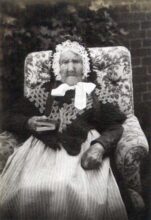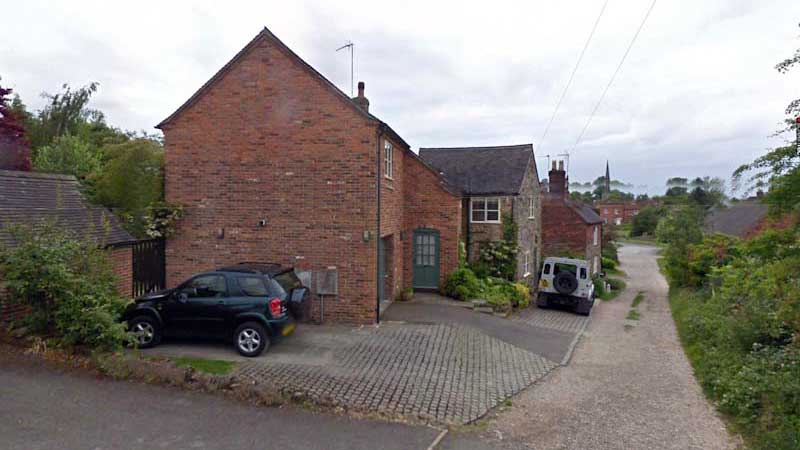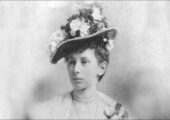Thomas was born in Ticknall in 1825 to John and Elizabeth Dunnicliffe.[1] (Elizabeth was part of the vast Banton family of Ticknall; this wouldn’t be the only connection Thomas has with the Bantons.) The Dunnicliffes go back, as far as I can tell, to Thomas’s grandfather Samuel who was born in Ticknall in 1754. Thomas’s father John worked as a Tailor, and 3 of John’s brothers followed in their father’s footsteps:[2] Joseph married and moved to Derby to start his tailoring business, but he died at only 38 years of age. Robert and George both married and moved to Melbourne. I don’t think they worked together and appear separately in the County Directories.[3]
Thomas’s brother John moved to Nottingham and became a Boot and Shoemaker,[4] and like Thomas, his other brother William was an Agricultural Labourer, but had married and moved to Chellaston.[5]

Selina’s mother Ann Banton lived to 101.
We find Thomas in 1841 aged just 15 working as an Agricultural Labourer for James Bradgate(?), a farmer and Publican in Ticknall. Nine years later on 14 October 1850, he married Selina Banton (his first cousin and only 17 years old, so a minor) in Ticknall.[6] Selina’s mother was the locally famous Ann Banton who lived to be over 100 years old.[7]
We find the two of them living next door to her mother, Ann in Banton’s Lane, Ticknall in the census of 1851. They have an 8-month-old daughter Elizabeth. Thomas is still working as an ‘Ag Lab’.[8]
The following year they had a son, George, but then, tragically, about a year later, in April 1853 their daughter Elizabeth died aged just 3 years of age. And just 3 months later Selina started to work as a Farm Labourer for the Calke Estate. I suspect that her mother, Ann was looking after George. She worked with the Farm Labourers and in the Park and Plantation from June 1853-February 1854 almost full time.
She worked with 3 or 4 other local women spudding thistles. This was a way of stopping the invasive thistle from spreading by bruising it with a ‘spud’ ( a long wooden stick with a flat metal end with a cutting edge).[9] They also spent several weeks raking leaves. The women were paid only half the wages of the men. Thomas also worked for the Estate in July and August 1853, along with lots of other local men to help with the haymaking, as did Selina in 1855, 1856 and 1858[10] She missed 1857 as she was pregnant with their 3rd child John who sadly died soon after birth.[11]
Their 4th child William was born in 1859 and it was around then that Thomas started to work full-time for 2 years for the Estate, either on the Parks and Plantation (fencing) or as a Road Labourer.[12] Thomas had started to work full-time for the Estate in 1866. He was one of the labourers who could turn his hand to anything and moved around between Farm, Park and Plantation, Roads, Improvements and even helping the gamekeepers, but finally settled as a Garden Labourer in 1868.[13]
Thomas (and Selina) would have walked the short distance over the fields from Banton’s Lane, bypassing the front of the house by walking in the shadow of the Haha, extending from the North East wing and around to the Garden Tunnel. Garden Labourers (and in Thomas’s time there were 7 regular ones) would do all the physical work in the Garden, digging, planting, weeding, seeing to the heating systems etc., all under the supervision of the Head Gardener, who at the time was John Trotter.
Thomas and Selina had 5 more children starting with Thomas in 1864, and amazingly it was at this exact time that Selina started to work full time as a Garden Labourer. I have not found any significant breaks in her employment which means she worked, in quite a physically demanding job, throughout her pregnancies, relying on her mother, I presume, to look after her young children.[14] I know she was working still in 1872, but the records are missing between 1872 and 1879 so I don’t know whether or not she was still working when she gave birth to their last child, Mary in 1874. Selina died in 1874, I will presume, either in childbirth or complications arising from it.[15]
In the census of 1881 Thomas was still in Banton’s Lane living with 4 of his children and his 90-year-old Mother-in-law (and aunt).[16]
Thomas in Court
In 1883 Thomas found himself in court along with 5 other Ticknall men, all being charged by Captain Freeman, the school attendance officer for the Ashby Union, with neglecting to send their children to school.[17] The 1880 Education Act was an extension of the 1870 Act making it compulsory for children aged 5 to 13 to attend school. Parents were expected to pay for their children to go to school. Only the poor went for free. The Local School Boards were expected to administer this, and they were given powers to decide whether age or educational standards were used to determine whether a child could leave school. I would guess that most used age as that was easier to administer. School Inspectors were sent to schools to look at attendance registers.
Looking at the ages of Thomas’s children at the time, it was most probably 11-year-old John and/or 9-year-old Mary who were not attending school. John (named after his elder brother who died when he was just a baby) was most probably already working doing occasional farm labouring etc. to help support his father and the family. As Thomas had a regular full-time job in the gardens at Calke, he maybe didn’t qualify for free education for his children.
The 1891 Census shows that Ann Banton is 100 years old. The Enumerator has highlighted this fact by writing her age in bold numbers. It must have been such a rare thing in those days. It is also the first time that Thomas refers to himself as a Gardeners Labourer. His youngest daughter Mary is living with them.
Thomas’s surviving sons mainly moved into industrial work in the coal mines and Tile works.
An interesting story concerning his son John emerged. John married Harriett Maria Stockwell, from Cirencester in 1895[18] and they settled in Bridge Street, Church Gresley.[19]
In the 1901 Census, they have a 1-year-old daughter, Gladys, and a 1-year-old Charles Stockwell, listed as a ‘nurse child’. This means that Harriet is nursing the child for another mother. In this case, the mother was her sister Kate. Charles was illegitimate and it would have seemed an ideal solution for Harriett to look after him alongside her own child. Kate was lucky to have family support because without it she would have struggled to keep Charles. In 1911 he was living with his Aunt Edith in Smethick, and going to school.[20] Sadly Charles died when he was only 13 years old.
Thomas died in 1895 aged 70, just 3 years after his mother-in-law, Ann, aged 101.[21]
[1] England select Deaths and Burials – ancestry.co.uk Jan 2024
[2] 1841 Census Ticknall – ancestry.co.uk Jan 2024
[3] 1852 Freebody’s Directory, Melbourne; City and County Directory 1895, Melbourne – ancestry.co.uk Jan 2024
[4] 1861 Census Radford Notts – ancestry.co.uk Jan 2024
[5] 1851 Census Chellaston – ancestry.co.uk Jan 2024
[6] Church of England Marriages and Banns – ancestry.co.uk Jan 2024
[7] 1891 Census Ticknall – ancestry.co.uk Jan 2024
[8] 1851 Census Ticknall – ancestry.co.uk Jan 2024
[9] Vrr.reading.ac.uk Jan 2024
[10] Time Books for Estate Workers – Calke Archive DRO Jan 2024
[11] Church of England Birth, marriages and death index – ancestry.co.uk Jan 2024
[12] Time Books for Estate Workers – Calke Archive DRO Jan 2024
[13] Time Books for Estate Workers – Calke Archive DRO Jan 2024
[14] Time Books for Estate Workers – Calke Archive DRO Jan 2024
[15] Ticknall Parish Records – ancestry.co.uk Jan 2024
[16] 1881 Census Ticknall – ancestry.co.uk Aug 2023
[17] Hinckley News 3rd Nov 1883 – FindMyPast Aug 2023
[18] Staffordshire Birth Marriage and Death indexes – ancestry.co.uk Aug 2023
[19] 1901 census Church Gresley – ancestry.co.uk Ag 2023
[20] 1911 Census Smethick – ancestry.co.uk Aug 2023
[21] Ticknall Parish Records – ancestry.co.uk Jan 2024






Leave a Reply